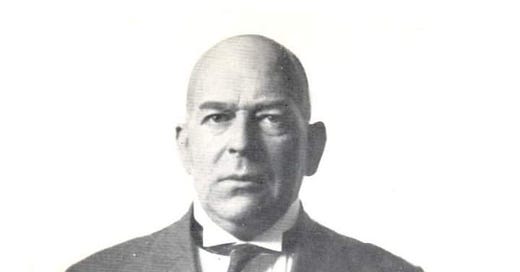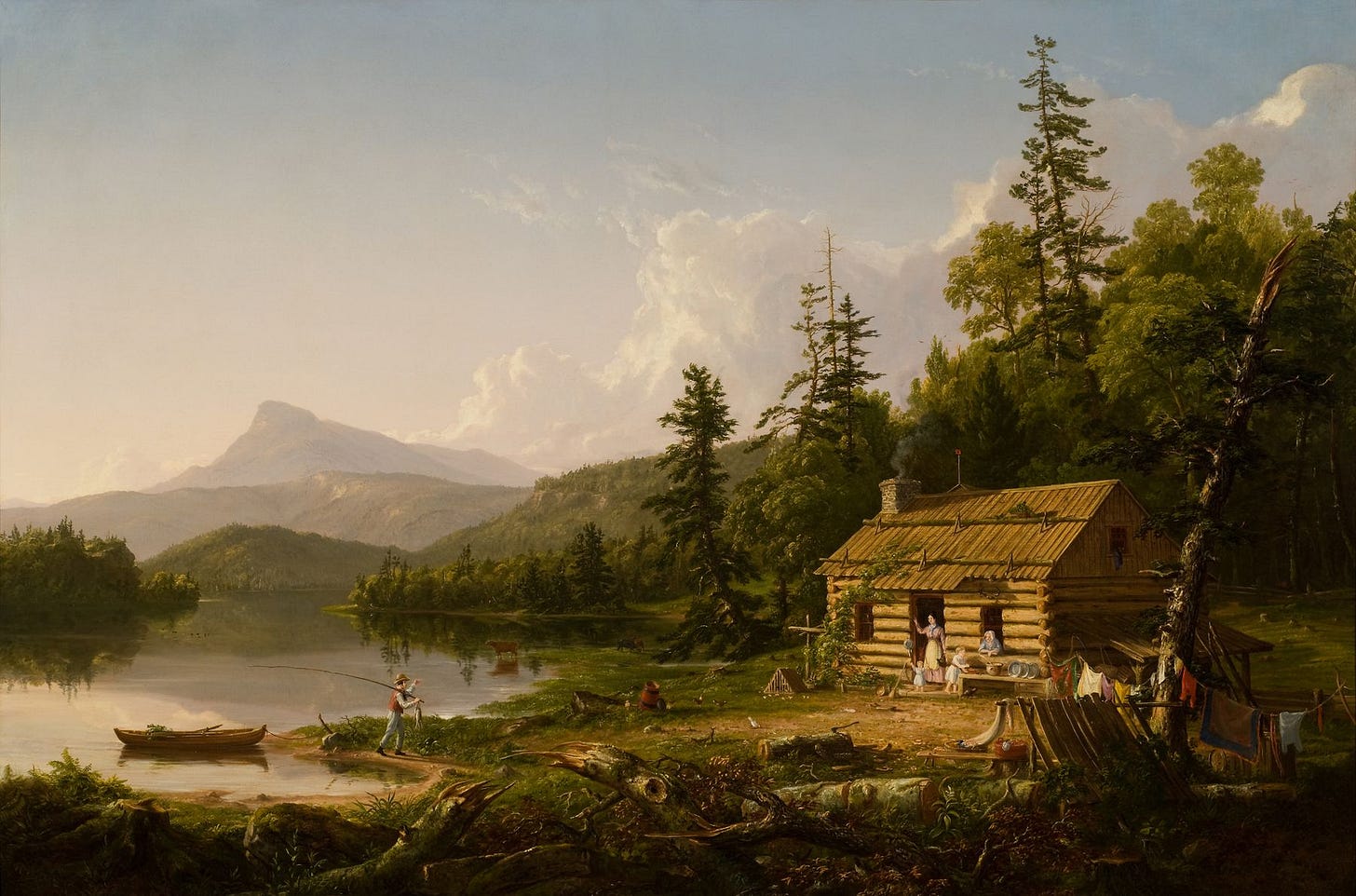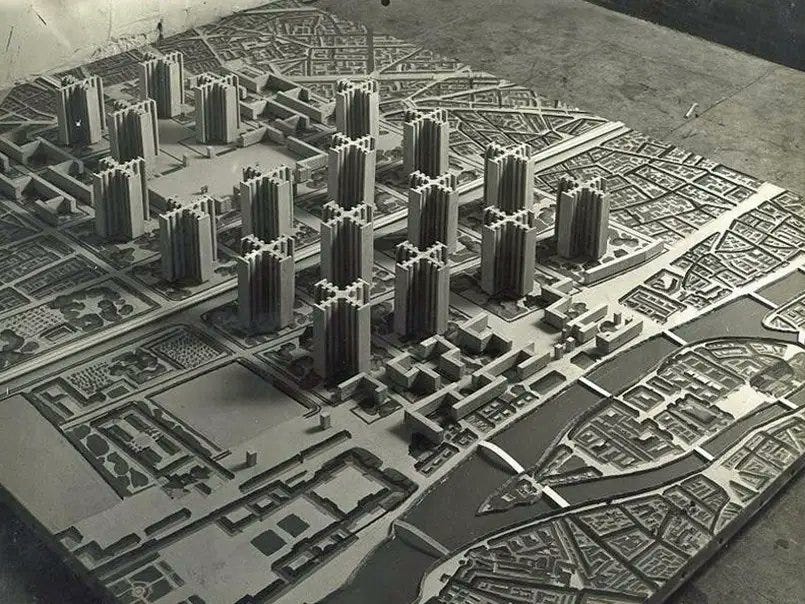The following is an excerpt from a paper I have written for a special issue on Oswald Spengler published by the Philosophical Journal of Conflict and Violence (PJCV). The link is on my bio.
In Spengler’s philosophy of history, a culture is only born through a rurally intuitive soul’s waking consciousness. This organic feeling and spiritual world-outlook, experienced in the early phase of any culture, are antithetical to the materialistic world-outlook evident in the final phase of all cultures. In The Decline of the West, Spengler initially explains the distinction between the countryside and city through a comparison between the crop agriculturalist and the hunter or pastoral farmer. To Spengler, primitive man is essentially an animal, whose waking-consciousness is constantly alert, due to the hostility of nature. The metamorphosis of man occurs upon the emergence of agriculture, whereby man infuses himself with the motherland. Thus, a peasant functions as a plant, as opposed to the hunter or shepherd, who functions more like an animal. Spengler illustrated:
He who digs and ploughs is seeking not to plunder, but to alter nature. To plant implies, not to take something, but to produce something. But with this, man himself becomes plant — namely, as peasant. He roots in the earth that he tends, the soul of man discovers a soul in the countryside, and a new earth-boundness of being, a new feeling, pronounces itself. Hostile nature becomes the friend; earth becomes Mother Earth.
To Spengler, the farmhouse, as opposed to the city skyscraper, is the embodiment of the organic condition which gives birth to every culture. Hence, every culture grows out of, and stays attached to, a specific motherland — the spiritual homeland of the respective culture. The Faustian Western culture, which this paper attempts to address, stems from the Celtic and Germanic tribes of the Northern European plains and forests. As the second stage of the evolutionary process in the development of a culture, the town is also plantlike and detached from primitive man’s nomadistic nature. Thus, the relationship of the town with man mirrors the relationship between the cottage and the peasant — this attachment to the motherland and connection with a mother-landscape constructs the “high form-language” of the respective culture. It is only with the advent of civilization — the rise of the giant cities — that a culture severs its connection with the motherland, nature, and the countryside. What Spengler calls the “Intellectual nomad,” the man of the city, is purely microcosmic and homeless as the nomad, herdsman, and hunter, intentionally severing his connection with his roots. Spengler borrows the Latin expression Ubi panis ibi patria, meaning “where there is bread, there is my homeland,” in order to define the decisive trait which characterizes the intellectual nomad in the civilizational stage, as well as the primitive man of the pre-cultural stage, as exemplified by the Germanic migrations, as well as the modern intellectual nomad, whose “rootless intellect ranges over all landscapes and all possibilities of thought.” To Spengler, it is the town, and not the village at the early stages of the development of a culture, nor the city that appears at the late stage, that gives birth to the soul of the respective culture and shapes its history. Spengler argued that the greatest thinkers of all cultures resided in towns, if not the periphery of a town. Spengler stated that “cultures are town-cultures” and “world-history is the history of civic man.” Hence, the politics, arts, religion, sciences, and peoples of all cultures stem from their respective towns. Thus, in Spengler’s philosophy of history, there is a clear distinction between the man of the land and the city man.
In Spengler’s chef-d’oeuvre, the city is represented as the embodiment of dread and death, and totally antithetical to the cottage and town. In order to feel what the town and village man’s world-outlook is, one should place himself in the place of the individual in question. Instantly, the discrepancy between the man of the city and country becomes apparent: walls, streets and towers dominate the former’s vision, whereas the latter’s is dominated by natural landscape. Each lifestyle essentially shapes a completely different world-outlook: the former denies nature, whilst the latter confirms it. The village or town infuses itself with nature, as opposed to the totally artificial outline of the city skyline, which contradicts nature. Hence, what distinguishes the village and town from the city is not the size, but the relationship of each settlement with nature and the land. As previously mentioned, Spengler argued that agriculture attempts to alter nature whilst confirming its presence; the nature of farming does not sever man’s bond with the land — it roots him in the land, making him akin to a plant. The soulless city sets itself apart from nature and attempts to dominate it, as Spengler argued: “the stone city in which is housed a quite artificial living, that has divorced from mother earth and is completely anti-natural — the city of rootless thought, that draws the streams of life from the land and uses them up into itself.” Yet, and regardless of the necessary separation between man and nature embodied by the city, there is an attempt to recreate or imitate nature with the emergence of fountains in the place of springs, parks replacing pastures and woods, pools walled by hedges replacing ponds and meadows. The manipulation of nature by the city is not limited to the land, but is extended to the cosmos, since the city lights attempt to outshine the moon. Hence, Spengler stressed that economic and political history cannot be grasped without acknowledging that the marginalization from and manipulation of nature by the city are the manifestation of the death of a culture. Moreover, under his overly deterministic theory, the rise of the world-city and its detachment from nature are inevitable, as exemplified by his analogous study of past cultures. Spengler stated:
In all countries of all late cultures, the great parties, the revolutions, the Caesarism, the democracies, the parliaments, are the form in which the spirit of the capital tells the country what is expected to desire and if called upon, to die for.
The history of all cultures commences with what Spengler calls the “primary classes”: the nobility and the clergy. Prior to the emergence of the city, the opposition between these two classes dominates the history of the respective culture. With the rise of the cities, the dynamics of the history of a culture change, giving rise to new elements, specifically, the bourgeoisie, the intellectuals, and the third estate. The consciousness of the city is the embodiment of the bourgeoisie’s resistance against the primary classes; it is intellect and reason manifesting themselves in material terms. As the bourgeoisie, intellectual class, and third estate become aware of their separate existence, they attempt to reform the political and religious forms of the culture. In the West, the new religion of the third estate, namely, liberal science, is set up beside the old religious forms. Likewise, democracy is established as a political form in the name of the people, yet Spengler emphasized that this meant “exclusively the people of the city.” Spengler further stated that “Democracy is the political form in which the townsman’s outlook upon the world is demanded of the peasantry also.” Democracy as a political form is presumed to represent “the people,” yet Spengler underlined that “the people” in democracies imply the city people alone. Therefore, the city attempts to replace rural values with the “absolute idea of money as distinct from goods.” This is exemplified by merely comparing the rural conception of trade as opposed to the city; the rural mode of trade does not comprise the abstraction of value from goods, in contrast to the city, where the process is monetary. The initial purpose of the city is to overthrow, and ultimately defeat, “country and chivalry”; after eventually accomplishing that task, the city turns despotic, and the country begins “a hopeless defensive battle — in the spiritual domain against nationalism, in the political against democracy, in the economic against money.” At this point in the lifespan of a culture, money transforms and evolves into a power, rather than a mere currency. What occurs in turn is the appearance of a system that enforces dependency on money, just as the countryman is dependent on the soil. The difference here, however, is the fact that “the earth is actual and natural, and money abstract and artificial, a mere category,” Spengler says . Thus, at the pre-civilizational and pre-civic stage, the economy of a culture relies on the soil and climate. Gradually, as the city divorces the culture from the land, during the early civilizational phase or winter stage of cultural development, the absolute dictatorship of money directs the economic form of a respective culture, albeit appearing in a distinct form in every culture. As mentioned above, each season of the development of a culture represents a unique sentiment; the autumn phase is usually considered to be the flowering of a culture under Spengler’s morphology of world-history. Thus, all high-cultures analogously reach their peak of cultural creativity during the autumn phase, which paves the way for an enlightenment period, as illustrated by the rise of Sufism in the Magian or Arabian culture, which is homologous to the Sophists in the Classical culture and the Western rationalists under the Faustian culture. In a sort of Hegelian fashion, Spengler argued that the sentiment and spirit of each stage of the lifespan of a culture are reflected in the architectural and artistic forms. Therefore, the winter stage, epitomizing the death of a culture, gives birth to the world-city, “the center in which the course of world-history ends by winding itself up.” These world cities obliterate their very own motherland, reflecting the materialistic spirit of their times, under the guise of utility and prosperity. In contrast to the dynamic and youthful creativity of early and late Gothic architectural forms, the winter stage gives birth to soulless and purely functionalist modern architecture.
Although it appears to be picturesque and marvelous to the human eye, the world-city is, in Spengler’s dreary view, a “daemonic stone-desert,” the symbolic tombstone of the culture, exemplifying nothing more than noble death. Past high cultures have produced world-cities which have risen and collapsed along with their respective civilizations, as displayed in the chronicles of Alexandria, Thebes, Rome, Babylon, and Baghdad. Today, according to Spengler, the Faustian culture, “the only culture of our time and on our planet which is actually in the phase of fulfilment,” has produced the world-cities of Paris, London, and New York at the end of its life course. “The final cities are wholly intellect,” stated Spengler in his magnum opus, illustrating the cult of rationalism which dominates the mindset of the city and the civilizational or winter phase of every culture. This is again perfectly exemplified by a comparison of city houses as opposed to country houses. The latter architectural forms are sprung from the land and are thus a “creation of the newly awakened dream-heavy soul,” the former, on the other hand, have been formed simply by requirements of the spirit of commercial enterprise. The sea of houses in all cities is meaningless, when compared to the architectural forms of the three previous stages of cultural development; it is merely the dwelling place of the “intellectual nomad.” The formless mass of the world-cities is extremely expansive, it attempts to conquer nature through “multiplied barrack tenements and utility buildings,” and it demolishes the old organic architecture by removals or inorganic restorations. The arrival of the formless mass of houses marks the end of the organic growth of any culture and the commencement of the period of inorganic and limitless expansion. In turn, the world-city ironically enslaves man and, in effect, destroys him. Paradoxically, the macrocosm soil and land create man and the culture to which he belongs, yet the microcosm man attempts to exploit nature and subjugate it, only to be enslaved by microcosms of his own creation — money, city, and technics. Additionally, Spengler provides the reader with a precise prediction of Western cities following the year 2000, which seem to have a striking resemblance to the modern cities existent today:
I see long after A.D. 2000, cities laid out for ten to twenty million inhabitants, spread over enormous areas of country-side, with buildings that will dwarf the biggest of today’s and notions of traffic and communication that we should regard as fantastic to the point of madness.
Although the world-cities of all cultures adopt a chessboard form — which is the expression of soullessness — as exemplified by the Babylonian rectangle-blocks mentioned by Herodotus, the checkered pattern of Tenochtitlan witnessed by Cortez, or the chessboard scheme of Rhodes and Alexandria of Greco-Roman civilization, the world cities of the Faustian Western culture exhibit the same patterns, yet in a more extreme manner, due to the irresistible tendency of the culture towards the infinite, a trait inherent to Western European culture. Hence, the immense size of Western world-cities, due to the expansionist nature of the Western soul, is distinct from Classical world-cities, which tended to eliminate the suburbs from their urban planning and instead opted to thicken from within the nucleus, as the streets became narrower and the buildings increased in height, as evident by the renowned insulae, multi-story buildings which Crassus was deeply invested in. The Western soul’s yearning for the infinite allowed for maximum expansion towards the countryside as well as the skies, as perfectly epitomized by the cities of London and New York today.










Is it exclusively a Western/Faustian phenomenon though?
And is there any realistic alternative to this dynamic, given the clear consistent rise in urban population % of total over the centuries?
" Spengler argued that the greatest thinkers of all cultures resided in towns, if not the periphery of a town."
"The history of all cultures commences with what Spengler calls the “primary classes”: the nobility and the clergy."
Not having read much Spengler, these two quotes from your essay, highlight that he must have been some sort of apologist for a romantic view of the Holy Roman Empire (HRE)? (Of which Köln was the pre-eminent city for a long time and never capital) (I agree a lot with what he says about capitals, those parochial cesspits.)
The identification of nomadism with the city, however, as both rootless ( 'Stadsluft macht frei nach Jahr und Tag' ) is another giveaway to this HRE context. Pesky traders and their wiles, damn those anarchists ruining perfectly good blood and soil types.
Given other peeps structure their arguments with the binary that nomadism and city-life are the opposites that rub life into our limbs, bashing them into the same 'thing' is very strange to me. I feel no true nomad would consider a rural villager any more/less 'hoofless' than their city cousins.
The sensitivity to scale is important here, most of what Spengler might consider rural in Europe from my Australian eyes looks like hobby farming, or lifestyle blocks. And in Australia the settlement pattern is such that the 'country' is an outgrowth of the city (trade with the empire trading system). Which is why we have more terms than Europe for areas besides village-town-city spectrum in the rural-city dichotomy. In Australia, in relation to a folk geographic-eco-taxonomy, we have:— city & small towns (we have no villages in Australia) which become the rural areas by way of hobby farms, then we have 'the bush' which includes the outskirts of cities and towns (also called the urban-bush interface that are talked about as 'more bush that city') as well as all of the countryside that is 'rural' proper. Further out, and which are also included in that term 'the bush', is the 'outback' which includes both wilderness areas and agricultural 'stations' like sheep stations (as opposed to ranches with 'ranges') the size of middling HRE entities, and all of these categories run roughshod over Country, in my case the Murwinna near nipaluna. They go back 15-50K++ years and make Spengler's view on antiquity look positively ingénue.
Spengler is also right, even if his frame is wonky. We have no access to Spengler's 'rural' or 'town' in Australia (life goes on), when we look at suburbia in particular, and the city overcomes the rural into megalopolis and their supply regions, but I would argue the rural, even Spengler's rural idyll, is always part of a city network, much like nomads are always in trade with settled economies. So.…
Spengler romanticises some epoch (possibly in a pure never existing form) of the HRE. This is hilarious.
Thanks for this educative essay.